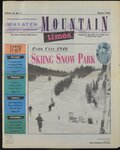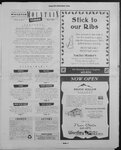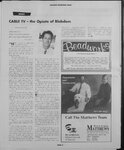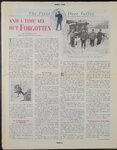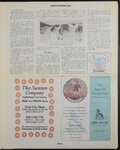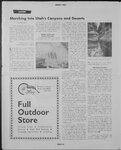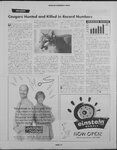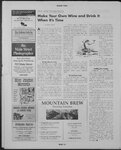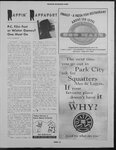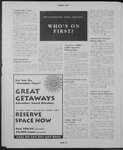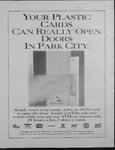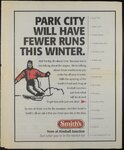| OCR Text |
Show MARCH The AND A TIME 1996 Deer First Valley ALL BUT FORGOTTEN By Christopher Smart Photos Courtesy of Otto Carpenter rwvhere was a time when Deer Valley was not a glitzy ski resort with movie stars and haute cuisine. There was a time, all but forgotten now, when Deer Valley, like the litthe mining town of Park City, was a quiet, down home place. Long distance travel was accomplished by train, when it was done at all. It was a time when you knew who lived next door. It was an era when two local guys could simply build their own ski resort with their own two hands No one remembers exactly just what it was that got into Otto Carpenter and Bob Burns: why one day they looked at each other and said, hey, let’s build a ski resort. But that’s what they did. And they called it Snow Park. It was just about 50 years ago. To get to Snow Park, you drove up past the railroad depot at the bottom of Main Street, and east up Heber Avenue, where only one whorehouse remained from Park City’s boom days. It was up in the little basin above Park City, where Otto and Bob had been measuring snow for a number of years. Park City was little then. It wasn’t just little, it was tiny. Maybe two thousand residents, or so. It was a town where everyone knew everyone else. And in those days, that meant helping your friends and neighbors. The Outdoorsman and The Machinist Both Otto and Bob had worked for the mines at one time. But by 1945, as the war ended the silver mines were falling on hard times. Otto and Bob had moved on: Otto had become a carpenter. But that doesn’t begin to describe Otto Carpenter at all. He was the ultimate outdoorsman: a fisherman, hunter and skier. In fact, in the late 1920s Otto took up ski jumping with Alf Engen and his brothers. Many old family photos show Otto launching off Ecker Hill and other favorite jump sites like an eagle, his arms outstretched. The old, black and white photos show a tiny figure in a big sky. One of Otto’s sons, Richard, now in his 50s, points the figure out, saying that was the classic Otto Carpenter form. “The Engens used to jump with their hands down at their sides. But dad would have his arms right out in front, over his head,” Richard recalls. And their equipment was not the best. “He used to make his own skis,” Richard remembers. “They'd cut the wood and then steam it and bend it into form. He had some concoction that he’d mix up and paint on the bottom for a base.” Built by Hand It was, indeed, a different era in America. It was the time of the generalist, rather than the specialist. Otto Carpenter was the type of guy who would make his own skis and who would select trees from a forest, log them, and then mill the logs to build his own house. Today, Otto is 92 and still lives in the house he built for his family on Norfolk Avenue. Out in back is the ticket booth, all that remains of Snow Park. Known as quite a character in his time, on this day Otto is not up to talking about Snow Park. If Otto Carpenter was the consummate outdoorsman, Bob Burns was the quintessential tinkerer and a machinist — the guy with what used to be called “American Know-how.” Bob died in an explosion at his home on Woodside Avenue in November 1981, as he worked with an acetylene torch. Ironically, he died just as the brand new Deer Valley resort was starting up its chairlifts for the first time. Everyone remembers Bob as the one with the ability to create Snow Park’s chairlifts from the materials you might expect to find lying around an old mining town. One of his sons, Darrel, remembers that his father produced the bullwheels for the lifts as well as its chairs. They acquired the cable for the chairlift from the mine company. “My father and Otto spliced the cable themselves. And we helped, as much as little boys can help,” Darrel remembers. The lift towers, too, were built by Otto and Bob. “All the towers were built PAGE Bob Burns and crew at Snow Park. Inset: Otto Carpenter. from the mature trees they cut to clear the runs,” Darrel explained. “Between the two families, we cut all the scrub oak by hand with what is called a brush hook,” Darrel recalled. “The runs we used are still there, although some have been altered.” ichard, who appears in the cover photo was seven when it was shot bout 1953. Darrel was about 12 or 13 when they cranked up the lifts for the first time in 1946. They talk in matter-of-fact terms when remembering Snow Park, as though they could have been skiing there recently. But things have changed so much, it’s difficult to imagine the time or the place. “The first lift they built was a T-bar,” Darrel explains. “My dad built all the brackets, everything. You name it, he built it.” But some years, the snow was so deep the T-bar would get buried. The next step was a chairlift, high enough off the ground to move over the snowdrifts. “(Bob) designed the power train, the gearing to make it run the right speed. He even built the chairs,” Darrel says proudly. An engine from an old Ford powered the lifts. But it was located at the top of one of two chair lifts and either Bob or Otto would walk up the liftline through deep drifts to start it up. “Some of those cold mornings, it was hard turning the engine over. Dad used to hike up the hill all the time when the kids couldn't get the lift running,” Richard says from the living room of his father’s house, while looking over old photos. “We'd tie the gas can on the chairlift and that would be the first chair up... There’d be days when you broke a tower and had to go get another log,” he mused. It was during this same period that the first commercial chairlifts were installed at Brighton and Alta. Richard 8 recalls that a day pass at Snow Park was only about two dollars and a ten-rider was $1.50. But if you didn’t have that kind of money — and many didn’t - that didn’t mean you weren’t going to ski, not in Park City, anyway. “Anybody who wanted to ski would help Dad and Bob out. If they didn’t have the money, they’d let them ski anyway,” Richard said. “All the local kids, who are about 60 now, we all ran the lifts.” Like many people who started skiing as youngsters, Richard doesn’t remember learning how. “Dad didn’t teach us too much. We were just over there skiing. I don’t know who taught us.” Most of the kids in town soon became powder hounds. And when the snow got cut up, they’d group together to pack the runs with their skis. But Richard does remember his father fashioning ski poles for him from pool cue-sticks, the small, tapered tips were fitted With baskets. Darrel Burns remembers his skis precisely. “If you were lucky, the hicko‘ry were the top of the line. The others were just soft wood, no laminations.” It was sometime in the late ‘40s or early ‘50s that metal edges were discovered at least in Utah. “My dad built a router for the skis and then put on his own edges,” Darrel remembers of his father’s ingenuity. The Original Snow Park Lodge Bob and Otto built the Snow Park lodge themselves, not far from where the present-day Snow Park Lodge sits — but far removed in look and feel. Today’s Snow Park with towering ceilings, famous for its pastries and seafood delicacies, was nothing like the original, where Rintha Burns and La Rue Carpenter fixed chili and hamburgers for red-cheeked skiers. Continued on page 9 |
